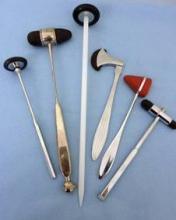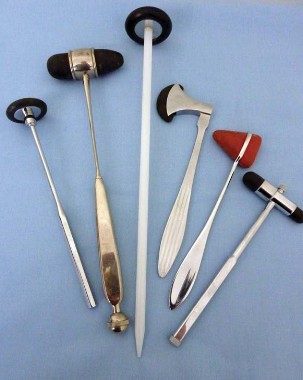User login
A neurologic exam involves a number of different elements: strength, coordination, cranial nerves, sensation, reflexes, gait, and a few others.
Certainly, not all of these elements are needed in every circumstance and are often not critical. Nonetheless, we check them, such as vibratory sense in simple migraine patients and carotid auscultation in carpal tunnel syndrome.
Is all of this necessary? Probably not. Do we still do it? Of course. Some of it is for documentation. Part of it is being thorough. (Neurologists, by nature, tend to be a compulsive bunch.) And there’s also habit – once you get into a certain pattern of doing an exam, it becomes a fixed routine.
There’s another intangible that’s rarely talked about: show time and magic. Like our witch doctor ancestors, we also have to make people believe in us. All those degrees on the walls (or lack thereof, in my case) may not convince some, so we pull out our wands. We have a Queen Square hammer instead of a Taylor (a.k.a., Tomahawk). Checking vibratory sense in every migraine patient may not be needed, but it’s a step up from most internists. It shows a patient that we’re looking for details others didn’t think of. It adds an element of mystery and interest to the magic of seeing a subspecialist. And, of course, hopefully convinces them that we’re worth the higher copay.
It might be easier and faster for many things if we just checked a few basic exam features. It likely wouldn’t change our plans in most cases. But it would take some of the luster off our profession and the way patients perceive us.
Even in modern medicine, image plays a big part. And a new curtain rises every time we start seeing a patient.
Dr. Block has a solo neurology practice in Scottsdale, Ariz.
A neurologic exam involves a number of different elements: strength, coordination, cranial nerves, sensation, reflexes, gait, and a few others.
Certainly, not all of these elements are needed in every circumstance and are often not critical. Nonetheless, we check them, such as vibratory sense in simple migraine patients and carotid auscultation in carpal tunnel syndrome.
Is all of this necessary? Probably not. Do we still do it? Of course. Some of it is for documentation. Part of it is being thorough. (Neurologists, by nature, tend to be a compulsive bunch.) And there’s also habit – once you get into a certain pattern of doing an exam, it becomes a fixed routine.
There’s another intangible that’s rarely talked about: show time and magic. Like our witch doctor ancestors, we also have to make people believe in us. All those degrees on the walls (or lack thereof, in my case) may not convince some, so we pull out our wands. We have a Queen Square hammer instead of a Taylor (a.k.a., Tomahawk). Checking vibratory sense in every migraine patient may not be needed, but it’s a step up from most internists. It shows a patient that we’re looking for details others didn’t think of. It adds an element of mystery and interest to the magic of seeing a subspecialist. And, of course, hopefully convinces them that we’re worth the higher copay.
It might be easier and faster for many things if we just checked a few basic exam features. It likely wouldn’t change our plans in most cases. But it would take some of the luster off our profession and the way patients perceive us.
Even in modern medicine, image plays a big part. And a new curtain rises every time we start seeing a patient.
Dr. Block has a solo neurology practice in Scottsdale, Ariz.
A neurologic exam involves a number of different elements: strength, coordination, cranial nerves, sensation, reflexes, gait, and a few others.
Certainly, not all of these elements are needed in every circumstance and are often not critical. Nonetheless, we check them, such as vibratory sense in simple migraine patients and carotid auscultation in carpal tunnel syndrome.
Is all of this necessary? Probably not. Do we still do it? Of course. Some of it is for documentation. Part of it is being thorough. (Neurologists, by nature, tend to be a compulsive bunch.) And there’s also habit – once you get into a certain pattern of doing an exam, it becomes a fixed routine.
There’s another intangible that’s rarely talked about: show time and magic. Like our witch doctor ancestors, we also have to make people believe in us. All those degrees on the walls (or lack thereof, in my case) may not convince some, so we pull out our wands. We have a Queen Square hammer instead of a Taylor (a.k.a., Tomahawk). Checking vibratory sense in every migraine patient may not be needed, but it’s a step up from most internists. It shows a patient that we’re looking for details others didn’t think of. It adds an element of mystery and interest to the magic of seeing a subspecialist. And, of course, hopefully convinces them that we’re worth the higher copay.
It might be easier and faster for many things if we just checked a few basic exam features. It likely wouldn’t change our plans in most cases. But it would take some of the luster off our profession and the way patients perceive us.
Even in modern medicine, image plays a big part. And a new curtain rises every time we start seeing a patient.
Dr. Block has a solo neurology practice in Scottsdale, Ariz.

